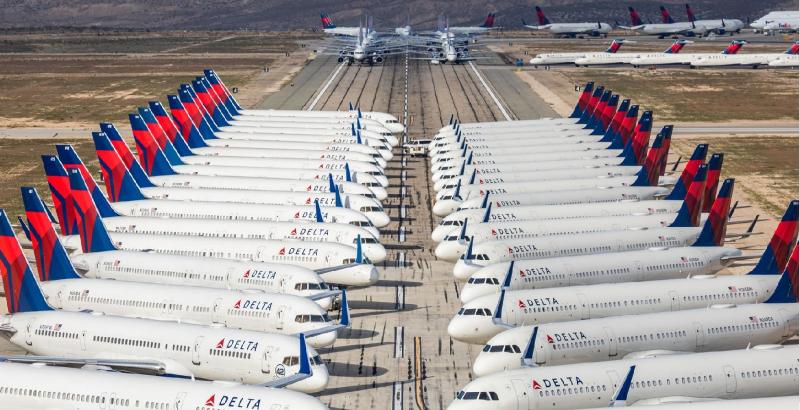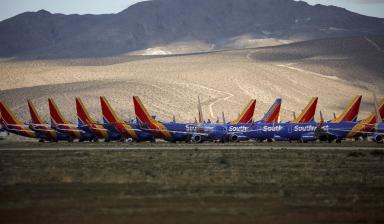Here’s What You Do With Two-Thirds of the World’s Jets When They Can’t Fly



The skies are eerily empty these days, presenting a new challenge for the world’s embattled airlines as they work to safeguard thousands of grounded planes parked wingtip to wingtip on runways and in storage facilities.
More than 16,000 passenger jets are grounded worldwide, according to industry researcher Cirium, as the coronavirus obliterates travel and puts unprecedented strain on airline finances. Finding the right space and conditions for 62% of the world’s planes and keeping them airworthy have suddenly become priorities for 2020.
Aircraft can’t simply be dusted back into action. They need plenty of work and attention while in storage, from maintenance of hydraulics and flight-control systems to protection against insects and wildlife — nesting birds can be a problem. Then there’s humidity, which can corrode parts and damage interiors. Even when parked on runways, planes are often loaded with fuel to keep them from rocking in the wind and to ensure tanks stay lubricated.
“Nobody thought this magnitude of preservation would need to be done,” said Anand Bhaskar, chief executive officer of New Delhi-based Air Works, a plane repair and maintenance company. “Parking space is a problem. These are logistics nightmares which we’re trying to work around.”

Mass Grounding
The number of passenger jets in service is the lowest in 26 years, according to Cirium. Managing such large-scale storage is a challenge for an industry already in crisis, with airlines worldwide slashing capacity to close to zero or not flying at all. The International Air Transport Association has warned that revenue from flying passengers could drop by nearly a third of a trillion dollars this year and that 25 million jobs are at risk.
Airlines are hunting for space on the ground at airports or in longer-term storage facilities in arid places such as Australia’s outback and the Mojave Desert in the U.S. At Amsterdam Airport Schiphol, KLM Group has more than 200 aircraft at gates and on a runway, arranged according to size and type, and ensuring enough space for them to be towed if maintenance is required, according to a post on the company’s website.


“Schiphol is packed,” KLM Community Manager Annemiek Cornielje wrote. “Not with passengers, unfortunately, but with the many aircraft parked on the ramp and even on a runway. Choreographing this sad and unique sight is quite a parking-puzzle,” she said, adding that Schiphol isn’t charging parking fees.
Charges differ from airport to airport. In India, parking alone can cost $1,000 a day for a large aircraft, according to Mark Martin, founder of Dubai-based Martin Consulting LLC. For an airline with a fleet of more than 250 jets, even heavily discounted rates may mean expenses of $12.5 million for a six-month grounding, without taking into account maintenance costs, he said.
In its online magazine, IATA said it asked governments to cut parking fees, which usually account for less than 2% of airport revenue in a normal year. Under current circumstances, those charges could “make-or-break” some airlines, it said.
Shampoo and Clean
Abu Dhabi-based Etihad Airways PJSC said its engineers are working around the clock maintaining its grounded fleet, a process that includes running engines and powering up aircraft, checking flight controls, and covering sensors and engines to protect inner workings from sand and dust. About 200 staff per shift clean plane cabins in hangars, from replacing seat covers to shampooing carpets, according to a video on the airline’s official Twitter account.
“I’ve never seen anything like this before in my aviation career,” Etihad’s Head of Technical Operations Gary Byrne said. The aircraft “are very intricate, complex pieces of machinery — it’s not like parking a car.”
Tires also need attention. Qantas Airways Ltd. said all planes from Boeing Co. 737s to Airbus SE A380s need to have their wheels rotated — by being towed on the tarmac or jacked into the air to be spun — every one to two weeks, while hydraulic fluid is put on landing gear to protect against rust. Giant silica moisture absorption sachets are also put inside engines to keep them dry, while all external holes on the fuselage are covered to block insects and nesting birds.

Qantas said it has more than 200 aircraft, including Jetstar’s Boeing 787 Dreamliners, parked at airports around Australia. The country’s climate makes it more suited for storage, especially compared with much of Asia, which has high levels of humidity as well as the threat of typhoons. Near Alice Springs in the Northern Territory, Asia Pacific Aircraft Storage Pty is holding aircraft for the likes of Singapore Airlines Ltd. and Fiji Airways.
The storage firm is expanding capacity to about 70 aircraft and considering raising that to more than 100, according to Managing Director Tom Vincent.
“There is a scramble for proper storage facilities,” he said. “We have a large number of deliveries over the next coming weeks and months.”
Asia Pacific has been a rapidly growing aviation market, with a slew of budget carriers from Indonesia, Vietnam, Malaysia, India and elsewhere ordering thousands of planes, buoyed by an emerging middle class embracing flying. That expansion came to a screeching halt because of the coronavirus, which has also hit orders for manufacturing giants Boeing and Airbus.
Finnair Oyj has parked aircraft at its Helsinki hub and has capacity if needed to use airports in Tampere and Rovaniemi, the capital of Lapland province. Work includes reconnecting aircraft batteries every 14 days, the airline said on its website. One a month, a more extensive check is carried out that involves removing protective covers, starting engines and inspecting air-conditioning and anti-ice systems.
One big challenge with parked planes is brakes, which can fade within 24 hours, according to Finnair Vice President of Ground Operations Jukka Glader. Each of its jets requires 10 to 12 chocks behind the wheels to keep them in position. With so many aircraft grounded, Finnair ordered 500 wooden “corona chocks” from a local carpentry shop.
Parking Spots
British Airways has parked half of its fleet of 12 Airbus A380 superjumbos in Chateauroux, France, for longer storage. Tarmac Aerosave SAS , which has storage sites in France and Spain, is working to handle higher volumes of requests, while ComAv LLC is also experiencing increased demand for its facility at the Southern California Logistics Airport in Victorville, to the northeast of Los Angeles.

At crowded airports like in New Delhi, which doesn’t have spare parking spots, a runway has been converted into a temporary storage area, like at Schiphol.
“Whether it’s the multiple control surfaces or avionics or hydraulic systems, prolonged storage effectively means an impact to airworthiness,” said Satyendra Pandey, an independent consultant and former head of strategy at Go Airlines India Ltd . “Long-term storage is a specialized skill and ideal in dry and hot environments. This aspect will have to be revisited as currently airplanes are parked at airports and runways across the globe.”
Among other carriers, United Airlines Holdings Inc. expects to park about 400 aircraft, mostly at its hubs like Newark and Chicago, a spokeswoman said, while Delta Air Lines Inc. has sent planes to Pinal Airpark near Tucson, Arizona. American Airlines Group Inc. is using a maintenance base in Tulsa, Oklahoma, and facilities elsewhere.
“It might seem a simple task, but there’s some nuance to it,” APAS’s Vincent said. “It doesn’t just stop, there are the continuous, periodic checks.”
 Article is LOCKED by moderator [smarty_function_ntUser_get_name: user_id or profile_id parameter required]
Article is LOCKED by moderator [smarty_function_ntUser_get_name: user_id or profile_id parameter required]








Shades of Hickam Field, December 7, 1941 with so many planes filled with fuel sitting wingtip to wingtip.
No politics please.
not too hard to predict some eventual outcomes for some cash strapped or state owned airlines when they start flying again. looks like I'll be driving for awhile.
A lot of maintenance.
I have seen several articles about people turning planes into homes.